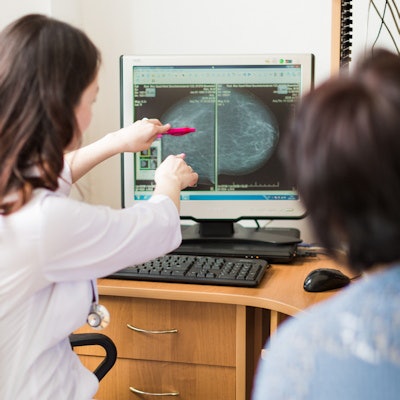
A method of shear-wave ultrasound imaging called sound touch elastography (STE) can help identify breast malignancies by measuring tissue stiffness around lesions, a Chinese study published June 4 in Ultrasound in Medicine & Biology has found.
Researchers led by Ya-Yun Cui from the First Affiliated Hospital of Anhui Medical University found that elastography showed high marks in sensitivity, specificity, and area under the curve (AUC) by reflecting collagen fiber content.
"With the development of elastography technology, we can observe not only the morphology and internal blood flow characteristics of the lesion, but also the stiffness in and around the masses, which improves accuracy in diagnosing breast malignancy," Cui and colleagues wrote.
While mammography is the gold standard when it comes to detecting breast cancer, ultrasound is sometimes used for supplementary screening. Ultrasound is useful in the screening of women with dense breasts due to its high sensitivity, whereas mammography's sensitivity falls in dense breast tissue. However, ultrasound has lower specificity, and the study authors wrote that better methods are needed to accurately differentiate malignant masses from benign masses.
Ultrasound elastography, based either on strain or on shear waves, can evaluate tissue stiffness by providing information on the elasticity of tissue of interest. Previous research shows that malignant masses are usually stiffer and have more collagen fibers than benign masses.
Sound touch elastography, meanwhile, uses ultrawide beam tracking to display a real-time stiffness image of tissues, including peripheral tissue. While previous research has shown this technique's promise, no consensus exists on which area around breast lesions should be measured to predict malignancies.
Cui and colleagues wanted to use STE to measure elasticity values in different areas around breast masses and see how valuable they are in diagnosing malignant breast masses. They also wanted to explore the link between the collagen fiber content of tissues around a lesion and its elasticity value.
The researchers looked at data from 90 women between December 2020 and July 2021. Out of these, 50 women had benign breast masses and 40 had malignant masses.
The study authors also used shell function, which allows for quantitative assessment of peripheral tissue stiffness, to measure the maximum and average elastic values of tissues around masses. Annular shells ranging from 0.5 to 2.0 mm wide were used, recorded as corresponding max shell and average shell parameters.
| Comparison between conventional ultrasound and STE elastography in predicting breast malignancies | |||
| Conventional ultrasound | Elastography inside breast masses (max shell) | Elastography around breast lesions (max shell 2.0) | |
| AUC | 0.635 | 0.769 | 0.930 |
| Sensitivity | 95% | 67.5% | 87.5% |
| Specificity | 32% | 80% | 88% |
| Positive predictive value | 70.4% | 73% | 85.4% |
| Negative predictive values | 94.4% | 75.5% | 89.8% |
The researchers also found that age and the max shell 2.0 parameter were independent predictors of malignancy. The average ages of patients with malignant and benign masses were 53.3 and 39.8, respectively. However, no statistically significant difference in maximum diameter between malignant and benign masses was found.
The study authors also wrote that the max shell 2.0 parameter was "highly correlated" with the collagen fiber content of tissue in the malignant group (r = 0.877).
"Therefore, we speculate that the max shell of sound touch shear-wave elastography is valuable in diagnosing malignant breast masses by reflecting the collagen fiber content, which deserves investigation in depth in the future," they wrote.
The team also called for further multicenter research studies with larger populations to give more comprehensive and stronger evidence.




















